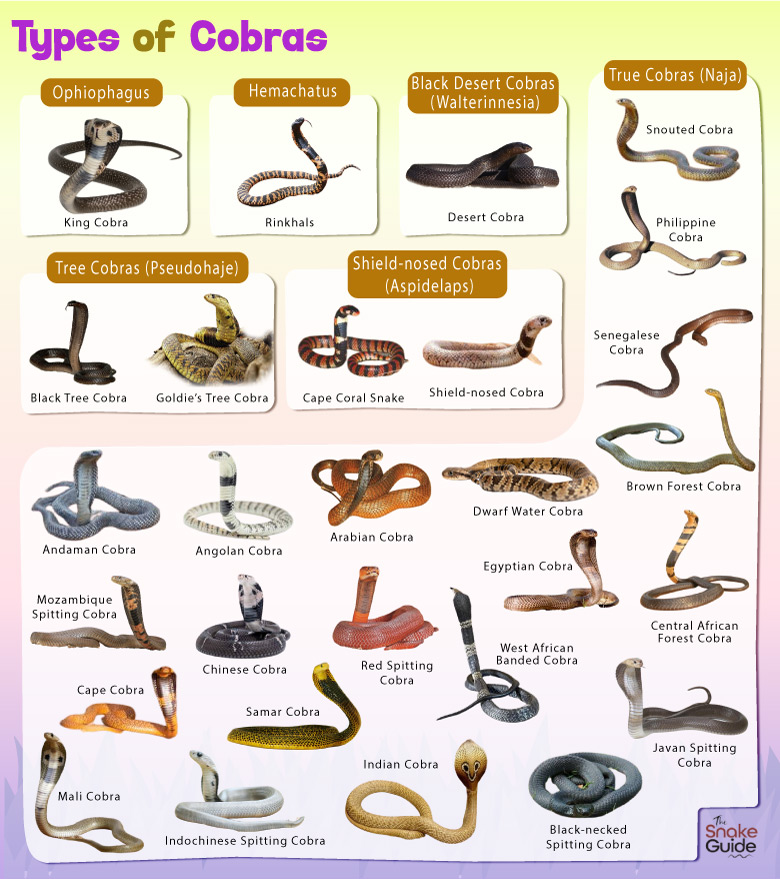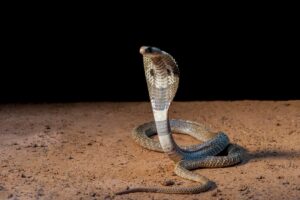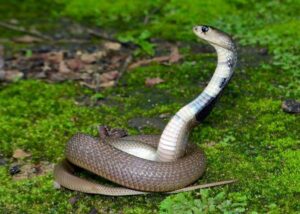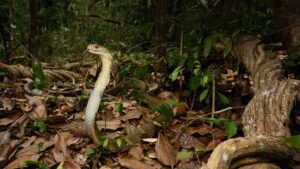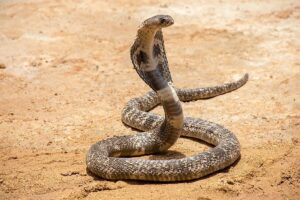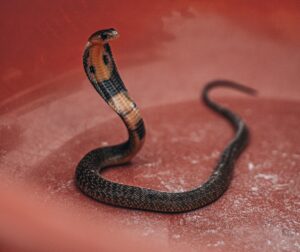Cobra
Cobra is a common name used to describe several members of the Elapidae family. The striking attribute shared by most of them is their tendency to “hood”, i.e., unfold the skin around the neck region to ward off threats. Like other elapids, these snakes are notorious for the potency of their venom.
Scientific Classifications
- Suborder: Serpentes
- Family: Elapidae
List of the Different Types of Cobras
True Cobras (Naja)
These are the largest genus of snakes colloquially called cobras.
- Andaman Cobra
- Angolan Cobra
- Arabian Cobra
- Ashe’s Spitting Cobra
- Banded Water Cobra
- Black Forest Cobra
- Black-necked Spitting Cobra
- Brown Banded Cobra
- Brown Forest Cobra
- Cape Cobra
- Caspian Cobra
- Central African Forest Cobra
- Chinese Cobra
- Congo Water Cobra
- Dwarf Water Cobra
- Egyptian Cobra
- Equatorial Spitting Cobra
- Indian Cobra
- Indochinese Spitting Cobra
- Javan Spitting Cobra
- Mali Cobra
- Mandalay Spitting Cobra
- Many-banded Cobra
- Monocled Cobra
- Mozambique Spitting Cobra
- Nubian Spitting Cobra
- Philippine Cobra
- Red Spitting Cobra
- Samar Cobra
- São Tomé Forest Cobra
- Senegalese Cobra
- Snouted Cobra
- West African Banded Cobra
- Zebra Spitting Cobra
Ophiophagus
The sole member of this genus is the hamadryad or King Cobra.
- King Cobra
Shield-nosed Cobras (Aspidelaps)
Named after the rostral scale on their noses, these snakes have less developed hoods than other cobras.
- Cape Coral Snake
- Shield-nosed Cobra
Tree Cobras (Pseudohaje)
As their name might indicate, these cobras are arboreal and spend a lot of time in trees. Their hoods are also less developed.
- Black Tree Cobra
- Goldie’s Tree Cobra
Black Desert Cobras (Walterinnesia)
The genus name of these snakes honors Egyptian zoologist Walter Francis Innes Bey. They live in the Middle East.
- Desert Cobra
- Walterinnesia morgani
Hemachatus
The sole member of this genus is the ring-necked cobra, better known as rinkhals.
- Rinkhals
Description
Size
On average, these cobras tend to be about 6 feet long. The Mozambique spitting cobra is the smallest at 4 feet, while the King Cobra reaches up to 18 feet, making it not only the longest cobra but also the longest snake species capable of producing venom.
Color and Appearance
The most notable feature of any species of cobra is its trademark hood, which it unfurls by spreading the ribs in its neck region and flattening part of its body close to its head. Only the black desert cobras do not display this behavior.
Unlike vipers, these snakes have hollow fangs incapable of holding prey down. Instead, they inject venom directly into their victims.
Coloration varies from species to species, with displays of black, red, and yellow being the most common. Banded and mottled patterns are also quite common.
Are they Dangerous to Humans
All cobras possess venom, the potency of which varies depending on the species. However, the venom of these snakes is neurotoxic, i.e., it causes damage to the nervous system. The symptoms of cobra venom include abdominal pain, anticoagulation, blurry vision, difficulty in breathing, difficulty in swallowing and when trying to talk, necrosis of tissue, and weakness of skeletal muscles. A bite from any of them can be fatal if left untreated, with the bite victim sometimes dying after 30 minutes.
Some species, like the spitting cobras, have cytotoxic venom, which they spit at their victims’ eyes. Besides causing permanent blindness in their victims, this venom can severely damage tissue, causing swelling, pain, and even necrosis.
However, they generally avoid confrontation with humans and attack only when threatened.
Cobras at a Glance
Distribution
Most cobras are found in southern Asia and Africa.
Habitat
They prefer hot tropical areas, spending most of their time underground, underneath rocks, or inside the hollows of some trees. But they have also been spotted in open woods, plains, rocky hillsides, and savannas. Cobras are even seen around farmlands, which increases the risk of human encounters.
Predators
Despite being fierce predators themselves, cobras face several threats in the wild. These snakes are hunted by birds of prey like eagles, hawks, and secretary birds, crocodiles, honey badgers, mongooses, and even other cobras.
To protect themselves and ward off threats, cobras put on a display that involves spreading their hoods and hissing loudly. Spitting cobras will shoot venom out of openings in their fangs to deter enemies further.
Lifespan
The average lifespan of a cobra is between 20-30 years.
Diet
Cobras tend to be opportunistic, feeding on whatever suitable meal comes their way. The average diet of a cobra includes carrion, eggs, small birds and mammals, lizards, and other snakes.
These snakes tend to hunt at dawn or dusk, though there have been reports of them hunting during the day. To locate prey, they flick their tongue in and out of their mouths, picking up odor particles and sending them to the Jacobson’s organ at the roof of the snake’s mouth. This process helps them detect nearby prey.
Depending on how full they are after their last meal, it can be a while until they need to feed again. Some snakes can go weeks, even months, without feeding.
Reproduction
Reproduction occurs via oviparity, with females laying an average of 20-40 eggs, which incubate for 40-80 days.
When the snakelets hatch, they are about 16-18 inches (40-45 cm). They become sexually mature at 4-6 years old.
Similar Species
While this snake also “hoods” like other cobras, it doesn’t rear its head backward like them when it wants to appear threatening. It instead stays in a horizontal position.
Also called the American cobra, this snake doesn’t rear its head or display a hood. However, it belongs to the same family and possesses the same potent venom as any cobra species.
FAQs
Ans: A group of cobras is called a quiver.
Ans: While several cobra species are at risk, only the São Tomé Cobra is considered “Endangered” or “EN” by the IUCN.
Source
imageio.forbes.com, thehindu.com, atlasobscura.com, worldatlas.com, reddit.com

